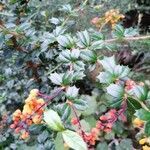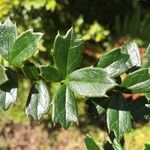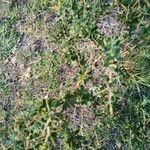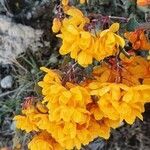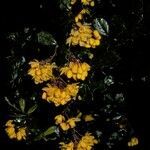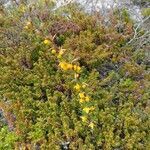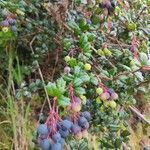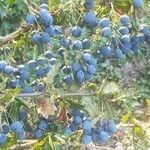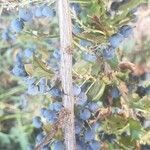Shrubs , evergreen, 1-3 m. Stems dimorphic, with elongate primary and short axillary shoots. Bark of 2d-year stems brown, densely tomentose. Bud scales 2-4 mm, deciduous. Spines present, pedately 5-9-fid. Leaves simple; petioles 0.1-0.3 cm. Leaf blade obovate, 1-veined from base, 1.7-3 × 0.9-1.2 cm, thick and rigid, base acute or acuminate, margins reflexed, undulate, toothed or shallowly lobed, each with 2-4 teeth or lobes 1-3 mm high tipped with spines to 1.2-1.6 × 0.2-0.3 mm, apex obtuse or rounded; surfaces abaxially glossy, smooth, adaxially glossy, green. Inflorescences racemose, rather dense, 10-20-flowered, 3-4 cm; bracteoles membranous, apex acuminate. Flowers: anther filaments without distal pair of recurved lateral teeth. Berries dark purple, spheric, 6-7 mm, juicy, solid.
Shrub to 3.5 m high; branchlets subterete, red-brown, shortly pilose, with spines. Leaves evergreen; lamina obovate to obovate-oblong, 1–2 cm long, 0.5–1.5 cm wide, cuneate at base, remotely spiny-toothed at margin, 3-spined at apex, thick, rigid, glossy dark green above, paler green below; spines slender, 3-or 5-partite, 3–10 mm long. Flowers golden, flushed with red; pedicel 6–10 mm long, red. Fruit globose, c. 6–7 mm long, dark blue, pruinose when ripe; style to 4 mm long, persistent.
An evergreen shrub. It grows 2.5-3 m high and spreads 3.5 m wide. The leaves are glossy and spiny. They are dark green above and paler underneath. They are small. They are like holly leaves. The flowers are small and cup-shaped and orange-yellow. They hang in large numbers among the leaves. The fruit are blue berries. They are 7 mm across. The fruit have many seeds.
